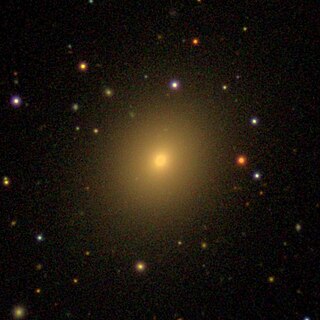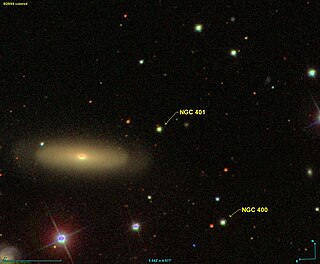
The New General Catalogue of Nebulae and Clusters of Stars is an astronomical catalogue of deep-sky objects compiled by John Louis Emil Dreyer in 1888. The NGC contains 7,840 objects, including galaxies, star clusters and emission nebulae. Dreyer published two supplements to the NGC in 1895 and 1908, known as the Index Catalogues, describing a further 5,386 astronomical objects. Thousands of these objects are best known by their NGC or IC numbers, which remain in widespread use.

The Little Dumbbell Nebula, also known as Messier 76, NGC 650/651, the Barbell Nebula, or the Cork Nebula, is a planetary nebula in the northern constellation of Perseus. It was discovered by Pierre Méchain in 1780 and included in Charles Messier's catalog of comet-like objects as number 76. It was first classified as a planetary nebula in 1918 by the astronomer Heber Doust Curtis. However, others might have previously recognized it as a planetary nebula; for example, William Huggins found its spectrum indicated it was a nebula ; and Isaac Roberts in 1891 suggested that M76 might be similar to the Ring Nebula (M57), as seen instead from the side view.

Messier 77 (M77), also known as NGC 1068 or the Squid Galaxy, is a barred spiral galaxy in the constellation Cetus. It is about 47 million light-years (14 Mpc) away from Earth, and was discovered by Pierre Méchain in 1780, who originally described it as a nebula. Méchain then communicated his discovery to Charles Messier, who subsequently listed the object in his catalog. Both Messier and William Herschel described this galaxy as a star cluster. Today, however, the object is known to be a galaxy. It is one of the brightest Seyfert galaxies visible from Earth and has a D25 isophotal diameter of about 27.70 kiloparsecs (90,000 light-years).

NGC 2537, also known as the Bear Paw Galaxy, Bear Claw Galaxy, Arp 6, or Mrk 86, is a blue compact dwarf galaxy in the constellation Lynx, located around 3 degrees NNW of 31 Lyncis. It was discovered on 6 February 1788 by German-British astronomer William Herschel.

NGC 1535, also known as Cleopatra's Eye, is a planetary nebula in the constellation of Eridanus, discovered by William Herschel on February 1, 1785. It is very similar to the Eskimo Nebula in both color and structure but the central star can be quite difficult to observe visually. The object is included in the Astronomical League's Herschel 400 Observing Program.

NGC 156 is a double star located in the Cetus constellation. It was discovered on 1882 by Ernst Wilhelm Leberecht Tempel.

NGC 203 is a lenticular galaxy located approximately 233 million light-years from the Solar System in the constellation Pisces. It was discovered on December 19, 1873 by Ralph Copeland.

NGC 207 is a spiral galaxy roughly 178 million light-years from the Solar System in the constellation Cetus. It was discovered on December 7, 1857, by R. J. Mitchell.

NGC 233 is an elliptical galaxy located in the constellation Andromeda. It was discovered on September 11, 1784 by William Herschel.

NGC 276 is a barred spiral galaxy located approximately 626 million light-years from the Solar System in the constellation Cetus. It was discovered in 1886 by Frank Muller and was later also observed by DeLisle Stewart.

NGC 777 is an elliptical galaxy in the constellation of Triangulum. It was discovered by William Herschel on September 12, 1784. It has a weak active nucleus of type Seyfert 2 or LINER 2, implying that the central region is obscured. It may be an outlying member of galaxy cluster Abell 262.

NGC 367 is a spiral galaxy in the constellation of Cetus. It was discovered in 1886 by the astronomer Frank Muller.

NGC 368 is a lenticular galaxy in the constellation of Phoenix. It was discovered by John Herschel on September 5, 1834.

NGC 370 is a triple star located in the constellation Pisces. It was recorded on October 7, 1861, by Heinrich d'Arrest. It was described by Dreyer as "very faint, 13th magnitude star 15 arcsec to south, diffuse." However, there is nothing there. It is now presumed to be either a lost or "non-existent" object, although it is possible it could be a duplication of NGC 372.

NGC 400 is a star located in the constellation of Pisces. It was discovered on December 30, 1866, by Robert Ball.

NGC 401 is a star located in the constellation of Pisces. It was discovered on December 30, 1866, by Robert Ball.

NGC 416 is a globular cluster located in the constellation Tucana. It was discovered on September 5, 1826, by James Dunlop. It was described by Dreyer as "faint, pretty small, round, gradually brighter middle". At a distance of about 199,000 ± 9,800 ly (61,000 ± 3,000 pc), it is located within the Small Magellanic Cloud. At an aperture of 31 arcseconds, its apparent V-band magnitude is 11.42, but at this wavelength, it has 0.25 magnitudes of interstellar extinction.

NGC 4531 is a spiral galaxy located about 50 million light-years away in the constellation Virgo. It was discovered by astronomer William Herschel on April 17, 1784. NGC 4531 is a member of the Virgo Cluster.

NGC 2074 is a magnitude ~8 emission nebula in the Tarantula Nebula located in the constellation Dorado. It was discovered on 3 August 1826 by James Dunlop and around 1835 by John Herschel. It is described as being "pretty bright, pretty large, much extended, [and having] 5 stars involved".

NGC 4179 is a lenticular galaxy located in the constellation Virgo. It was discovered by William Herschel on January 14, 1784. It is a member of the NGC 4179 Group of galaxies, which is a member of the Virgo II Groups, a series of galaxies and galaxy clusters strung out from the southern edge of the Virgo Supercluster.



















